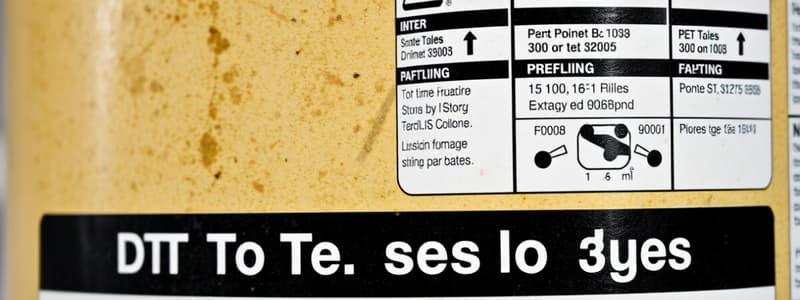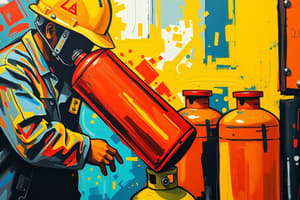Podcast
Questions and Answers
What does '3AL' indicate about a tank?
What does '3AL' indicate about a tank?
- The tank is made of steel.
- The tank can withstand high-pressure applications.
- The tank is compliant with international standards.
- The tank is manufactured from aluminum. (correct)
What happens when the pressure in the cylinder decreases below the valve's opening threshold?
What happens when the pressure in the cylinder decreases below the valve's opening threshold?
- The valve closes automatically. (correct)
- The valve leaks gas.
- The valve remains open until manually closed.
- The valve opens completely.
Why is it unsafe to use a regulator designed for one type of gas on a valve port of a different gas?
Why is it unsafe to use a regulator designed for one type of gas on a valve port of a different gas?
- It will not fit properly on the valve port.
- It causes excessive gas flow.
- It can lead to gas leaks and explosions. (correct)
- It leads to improper pressure readings.
What information does the number '2015' signify in the context of gas cylinders?
What information does the number '2015' signify in the context of gas cylinders?
What is indicated by the coding on large cylinder valve outlets?
What is indicated by the coding on large cylinder valve outlets?
What is the purpose of the pin index safety device?
What is the purpose of the pin index safety device?
What should be ensured when changing a gas cylinder?
What should be ensured when changing a gas cylinder?
Which component is used to manually operate the valve of a gas cylinder?
Which component is used to manually operate the valve of a gas cylinder?
Where should gas cylinders be placed for safety?
Where should gas cylinders be placed for safety?
Which part of the gas system is designed to relieve excess pressure?
Which part of the gas system is designed to relieve excess pressure?
What is the pressure in an E-cylinder of nitrous oxide when it is full?
What is the pressure in an E-cylinder of nitrous oxide when it is full?
Which of the following methods can be used to accurately determine the amount of nitrous oxide in a tank?
Which of the following methods can be used to accurately determine the amount of nitrous oxide in a tank?
At what ambient temperature does the saturated vapor pressure (SVP) of nitrous oxide in the tank measure 745 psig?
At what ambient temperature does the saturated vapor pressure (SVP) of nitrous oxide in the tank measure 745 psig?
How much gaseous nitrous oxide can a full E-cylinder evolve at 1 atm pressure?
How much gaseous nitrous oxide can a full E-cylinder evolve at 1 atm pressure?
What is the molecular weight of nitrous oxide if 44 g of it occupies a volume of 22.4 L at standard temperature and pressure?
What is the molecular weight of nitrous oxide if 44 g of it occupies a volume of 22.4 L at standard temperature and pressure?
Which component is part of the pressure-building circuit in a liquid oxygen system?
Which component is part of the pressure-building circuit in a liquid oxygen system?
What is the purpose of the pressure relief valve in the main pipeline?
What is the purpose of the pressure relief valve in the main pipeline?
Which component serves as an alarm for low liquid levels in a reserve system?
Which component serves as an alarm for low liquid levels in a reserve system?
Identify the function of the 'economizer' circuit in a liquid oxygen system.
Identify the function of the 'economizer' circuit in a liquid oxygen system.
Which of the following valves is used to isolate regulators for repair in a gas system?
Which of the following valves is used to isolate regulators for repair in a gas system?
Flashcards are hidden until you start studying
Study Notes
Cylinder Specifications
- DOT (Department of Transportation) indicates compliance with U.S. manufacturing standards.
- "3AL" denotes that the cylinder is made of aluminum.
- "2015" is the year of maximum filling pressure in psig (pounds per square inch gauge).
- Each cylinder has a unique serial number; "ALL GASS" refers to the owner's name.
Cylinder Valves and Connectors
- Large cylinder valves contain coded outlet ports corresponding to specific gas types, distinguished by thread type and diameter.
- Regulators designed for each gas type attach to threaded valve ports; incorrect connections can be hazardous.
- Small cylinders feature yoke design ports for gas flow in anesthetic applications.
Safety Features
- Safety relief devices act to release gas if pressure exceeds a set threshold, ensuring user safety.
- Pin index systems are used to prevent incorrect gas connections; two pins correspond to specific gas types and must be securely intact.
Storage and Handling of Cylinders
- Cylinders must be secured when placed upright to prevent tipping and damage.
- Liquid nitrous oxide equilibrium with vapor phase affects pressure readings; vapor pressure at specific temperatures must be noted (e.g., 745 psig at 20°C).
Medical Air Supply
- Medical air commonly supplied in yellow E-size cylinders containing 625 liters at a full pressure of 1900 psig.
- Air obeys Boyle’s law, and its contents cannot be determined solely by pressure gauge readings due to its gaseous state.
Determining Gas Containment
- To ascertain the quantity of nitrous oxide, weigh the cylinder and subtract the tare weight stamped on it; the result indicates the contained nitrous oxide weight.
- Avogadro’s formula states that one gram of any gas occupies 22.4 L at standard temperature and pressure.
Gas Cylinder Characteristics
- Common medical gases, including oxygen and nitrous oxide, are typically found in E and H cylinders.
- Variations in volume occur with temperature changes; nitrous oxide increases to 24 L at 20°C for the same mass.
Hospital Gas Systems
- Typical gas supply systems include compression systems for air; piped systems also employ valves, regulators, and alarms.
- Redundant compressors are essential for reliable medical air supply, ensuring system efficacy during failures.
Nitrous Oxide Standards
- Specific criteria govern nitrous oxide systems, with relevant sections of NFPA (National Fire Protection Association) and CSA (Canadian Standards Association) standards applicable to ensure safety and compliance.
Hospital Oxygen Supply Systems
- Large hospitals may utilize multiple systems for liquid oxygen: a main reservoir and a reserve reservoir.
- Key components in supply systems include fill lines, pressure relief valves, economizer circuits, gas regulators, and vaporizing units.
Oxygen and Nitrogen Cylinders
- Hospitals typically store H-cylinders of oxygen as a backup for pipeline failures.
- H-cylinders of nitrogen are also used to power gas-driven medical equipment.
- Uncommon configurations of gas use in operating rooms can be hazardous and must comply with safety regulations.
Properties of Oxygen
- Molecular weight of oxygen is 32; boiling point is −183°C at standard atmospheric pressure.
- Oxygen remains a gas under high pressure, with pressure dropping linearly as gas is used.
- Critical temperature for oxygen is −118°C; above this, it becomes gaseous regardless of applied pressure.
Cylinder Identification and Safety
- The pin index safety system, developed in 1952, helps prevent gas mix-ups through unique pin positions on cylinder yokes.
- Each gas type has designated pin positions to ensure correct connections, vital for safe operation.
- Mislabeling or improper handling of cylinders can lead to dangerous situations.
Cylinder Hazards
- Cylinders must be secured to avoid toppling; falls can lead to ruptures, creating high-pressure projectiles.
- Lightweight aluminum cylinders, filled to 3000 psig, pose significant hazards if ruptured due to large volumes of oxygen they contain.
Supply Chain Concerns
- Medical gases should be sourced from reputable suppliers to avoid dangerous inconsistencies in delivery.
- Studies indicate low rates of irregularities in supplied cylinders, but vigilance is necessary to ensure safety standards are met.
Studying That Suits You
Use AI to generate personalized quizzes and flashcards to suit your learning preferences.




